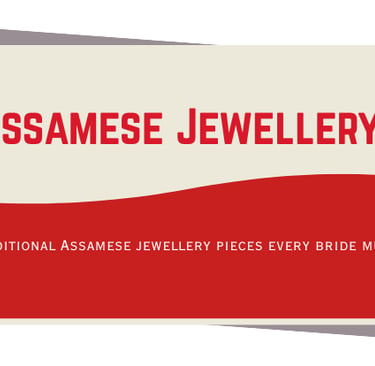List of traditional Assamese jewellery pieces every bride must have.
Blog post description.
ASSAMESE TRADITIONAL JEWELLERY
Kasturi Gogoi
11/7/20253 min read


Assamese bridal jewellery is more than just decoration—it’s a reflection of heritage, artistry, and cultural pride. Each ornament carries a unique meaning rooted in Assamese traditions, often inspired by nature, mythology, and local folklore. From the graceful Jonbiri and bold Gam Kharu to the elegant Loka Paro, these pieces tell the story of love, purity, and strength. Handcrafted by Assamese artisans, bridal sets are typically made of gold and feature intricate designs with red and green mina (enamel) work. Wearing these ornaments is a way for brides to embrace both beauty and cultural identity, connecting them to generations of Assamese women before them. Here’s a look at the most iconic traditional Assamese jewellery pieces every bride must have, each representing timeless elegance and symbolic significance.
Traditional Assamese Jewellery Every Bride Must Have
1. Jonbiri
A crescent-shaped pendant symbolizing the moon, Jonbiri reflects femininity, grace, and serenity. It’s often paired with traditional Muga silk sarees during weddings and festive occasions. Brides wear it as a centerpiece necklace to enhance the neckline and add a touch of royalty.
2. Gam Kharu
One of the boldest Assamese ornaments, Gam Kharu is a thick gold or silver bangle that represents strength and prosperity. Brides wear it as a statement piece, usually one on each wrist. The bangle’s simple yet powerful design makes it an inseparable part of Assamese bridal jewellery.
3. Dholbiri
Inspired by the Assamese musical drum dhol, this necklace features drum-shaped motifs arranged beautifully on a gold chain. It signifies joy and celebration—perfect for a bride stepping into a new chapter of life.
4. Dugdugi
Often confused with Dholbiri, Dugdugi has a more triangular, heart-like shape. It symbolizes love and affection, making it a romantic choice for brides. Its design often includes mina work and hanging beads that add a charming vintage appeal.
5. Loka Paro
This ornament is adorned with twin pigeon motifs, representing love, loyalty, and peace. Loka Paro earrings and necklaces are favorites among brides for their elegant symbolism and graceful detailing.
6. Thuria (Earrings)
Thuria are traditional Assamese earrings shaped like the sun or flower petals. Usually crafted in gold with enamel work, they signify radiance, energy, and happiness—qualities every bride is believed to embody.
7. Keru and Joonbiri Set
This set combines Keru, a smaller earring type, with Joonbiri, a crescent-shaped pendant. Together, they balance delicacy and elegance. Brides often wear this combination with traditional attire during the wedding reception.
8. Bena (Hair Ornament)
A Bena is a decorative hair accessory traditionally worn by Assamese brides during the wedding ceremony. It highlights the bun or braid and adds a regal finishing touch to the bridal look.
9. Galpata
A broad, collar-like necklace worn close to the neck. Galpata adds an aura of grace and strength. Its intricate filigree designs make it a standout bridal ornament, often passed down through generations.
10. Keru Bala and Muthi Kharu
These are lighter gold bangles often paired with Gam Kharu. Brides wear them to balance heavy and delicate elements, maintaining both comfort and traditional beauty.
FAQs
What metals are Assamese bridal jewellery made of?
Mostly gold, though silver versions are also popular, especially in traditional families.
Can modern brides wear Assamese jewellery with contemporary outfits?
Yes, many designers create fusion pieces that blend Assamese motifs with modern styles.
Is mina work common in Assamese ornaments?
Yes, red and green mina (enamel) work is a signature element of traditional Assamese jewellery.
Where can brides buy authentic Assamese jewellery?
From local Assamese jewellers, cultural fairs, or trusted online stores that specialize in regional ornaments.
Conclusion
Every Assamese bridal ornament tells a story of love, nature, and tradition. From the crescent charm of Jonbiri to the strength of Gam Kharu, these pieces connect modern brides to Assam’s artistic and spiritual legacy. Wearing them isn’t just about beauty—it’s about carrying forward a living tradition with pride and elegance.